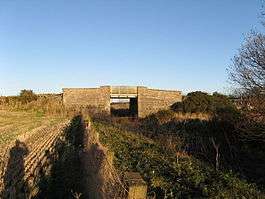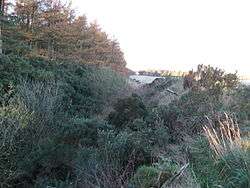Tillynaught railway station
Tillynaught railway station or Tillynaught Junction[5] was a junction railway station in what is now Aberdeenshire, Parish of Fordyce, 6 miles south-west of Banff. Tillynaught was opened in 1859 by the Banff, Portsoy and Strathisla Railway,[4] and in 1867 was absorbed by the Great North of Scotland Railway. This junction station was served by Aberdeen to Elgin trains as well as trains running to the branch terminus at Banff.
| Tillynaught | |
|---|---|
 The site of Tillynaught station | |
| Location | |
| Area | Aberdeenshire |
| Coordinates | 57.643221°N 2.670789°W |
| Grid reference | NJ 6005 6167 |
| Operations | |
| Original company | Banff, Portsoy and Strathisla Railway |
| Pre-grouping | Great North of Scotland Railway |
| Post-grouping | London and North Eastern Railway |
| Platforms | Three |
| History | |
| 30 July 1859[1] | Banff Line opened |
| 1 April 1884[2] | Line to Tochnineal opened |
| 1 May 1886 | Moray Coast Line opened[3] |
| 6 July 1964 | Banff branch closed to passengers[1] |
| 6 May 1968 | Banff and Moray Coast Lines closed to all traffic[1][4] |
| Disused railway stations in the United Kingdom | |
| Closed railway stations in Britain A B C D–F G H–J K–L M–O P–R S T–V W–Z | |
In 1923 the Great North of Scotland Railway was absorbed by the London and North Eastern Railway and in 1948 became part of British Railways. Recommended for closure by Dr Beeching's report "The Reshaping of British Railways" the station closed completely on 6 May 1968.
History
Banff, Portsoy and Strathisla

The Banff, Portsoy and Strathisla Railway opened on 30 July 1859, with a 16 1⁄4 miles (26.2 km) line from Banff to Grange, on the Great North of Scotland Railway (GNoSR) main line, with a 3 1⁄4 miles (5.2 km) branch from Tillynaught to Portsoy.[6] On 1 February 1863 the GNoSR took over services and the railway renamed the Banffshire Railway.
Moray Coast Line
A new station was built at Portsoy for the through line, which opened, together with a 4 1⁄2 miles (7.2 km) extension to Tochieneal, on 1 April 1884. The Countess of Seafield had not allowed a direct route to be built through Cullen House policies and to avoid the estate lands several bridges were and an impressive viaduct at Cullen had to be built. The Moray Coast Line opened on 1 May 1886, through Aberdeen to Elgin services called at Tillynaught.[3]
In 1923 the Great North of Scotland Railway was absorbed by the London and North Eastern Railway and railway nationalisation followed in 1948, services then being delivered by British Railways. The station and the line via Buckie was recommended for closure by Dr Beeching's in The Reshaping of British Railways,[7] closed on 6 May 1968.[4]
| Banff, Portsoy and Strathisla Railway | |||||||||||||||||||||||||||||||||||||||||||||||||||||||||||||||||||||||||||||||||||||||||||||||||||||||||||||||||||||||||||||||||||||||||||||||||||||||||||||||
|---|---|---|---|---|---|---|---|---|---|---|---|---|---|---|---|---|---|---|---|---|---|---|---|---|---|---|---|---|---|---|---|---|---|---|---|---|---|---|---|---|---|---|---|---|---|---|---|---|---|---|---|---|---|---|---|---|---|---|---|---|---|---|---|---|---|---|---|---|---|---|---|---|---|---|---|---|---|---|---|---|---|---|---|---|---|---|---|---|---|---|---|---|---|---|---|---|---|---|---|---|---|---|---|---|---|---|---|---|---|---|---|---|---|---|---|---|---|---|---|---|---|---|---|---|---|---|---|---|---|---|---|---|---|---|---|---|---|---|---|---|---|---|---|---|---|---|---|---|---|---|---|---|---|---|---|---|---|---|---|
| Overview | |||||||||||||||||||||||||||||||||||||||||||||||||||||||||||||||||||||||||||||||||||||||||||||||||||||||||||||||||||||||||||||||||||||||||||||||||||||||||||||||
| Locale | Scotland | ||||||||||||||||||||||||||||||||||||||||||||||||||||||||||||||||||||||||||||||||||||||||||||||||||||||||||||||||||||||||||||||||||||||||||||||||||||||||||||||
| Operation | |||||||||||||||||||||||||||||||||||||||||||||||||||||||||||||||||||||||||||||||||||||||||||||||||||||||||||||||||||||||||||||||||||||||||||||||||||||||||||||||
| Opened | 1859 | ||||||||||||||||||||||||||||||||||||||||||||||||||||||||||||||||||||||||||||||||||||||||||||||||||||||||||||||||||||||||||||||||||||||||||||||||||||||||||||||
| Closed | 1968 | ||||||||||||||||||||||||||||||||||||||||||||||||||||||||||||||||||||||||||||||||||||||||||||||||||||||||||||||||||||||||||||||||||||||||||||||||||||||||||||||
| Events | |||||||||||||||||||||||||||||||||||||||||||||||||||||||||||||||||||||||||||||||||||||||||||||||||||||||||||||||||||||||||||||||||||||||||||||||||||||||||||||||
| Successor line | Great North of Scotland Railway | ||||||||||||||||||||||||||||||||||||||||||||||||||||||||||||||||||||||||||||||||||||||||||||||||||||||||||||||||||||||||||||||||||||||||||||||||||||||||||||||
| Technical | |||||||||||||||||||||||||||||||||||||||||||||||||||||||||||||||||||||||||||||||||||||||||||||||||||||||||||||||||||||||||||||||||||||||||||||||||||||||||||||||
| Line length | 19 1⁄2 miles (31.4 km) | ||||||||||||||||||||||||||||||||||||||||||||||||||||||||||||||||||||||||||||||||||||||||||||||||||||||||||||||||||||||||||||||||||||||||||||||||||||||||||||||
| Track gauge | 4 ft 8 1⁄2 in (1,435 mm) | ||||||||||||||||||||||||||||||||||||||||||||||||||||||||||||||||||||||||||||||||||||||||||||||||||||||||||||||||||||||||||||||||||||||||||||||||||||||||||||||
| |||||||||||||||||||||||||||||||||||||||||||||||||||||||||||||||||||||||||||||||||||||||||||||||||||||||||||||||||||||||||||||||||||||||||||||||||||||||||||||||
The station infrastructure
In 1866-7 the station apparently had no sidings, possessing an island platform and only two buildings indicated.[8] By 1902 the junction had two signal boxes, a pedestrian footbridge, a weighing machine and a complex arrangement of sidings and points.[9] The Tillnaught Junction signalling diagram for 1934 shows a single wooden signal box, two sidings on the Banff side and [10] the sign stated Change for Ladysbridge and Banff.[11] The island platform once had an impressive overall canopy that had been removed by 1960.[12]
After closure the station buildings were demolished and the platforms infilled. The nearby station master's house and ancillary houses have been converted into a private dwelling.[13]
Services
Tillynaught had six trains a day to Portsoy after being taken over by the GNoSR, three of these reversed and continued to Banff.[14] Tochieneal had services from when the line reached there in 1886. The Moray Coast Line was served by four through trains a day between Aberdeen to Elgin and these trains called at Tillynaught.[15]
Portsoy was served by four Aberdeen to Inverness trains in the summer of 1948, with a mid-day Keith Town to Inverness service and an evening service from Aberdeen that terminated at Elgin. There were three through services from Inverness to Aberdeen, a service from Lossiemouth and Elgin to Aberdeen and a Saturday service from Inverness to Keith that after 19 June was accelerated and extended to Aberdeen. There were no Sunday services.[16]
Micro-history
The station was located in a very rural area and was named after a local farm and water mill.[17]
| Preceding station | Historical railways | Following station | ||
|---|---|---|---|---|
| Cornhill | Banff, Portsoy and Strathisla Great North of Scotland Portsoy branch 1859–1884 |
Portsoy | ||
| Cornhill Towards Grange |
Great North of Scotland Banff branch 1884–1886 |
Ordens Towards Banff | ||
| Cornhill Towards Keith and Aberdeen |
Great North of Scotland London and North Eastern British Railways Moray Coast Line 1886–1968 |
Portsoy Towards Elgin and Inverness | ||
References
Footnotes
- Butt 1995, p. 26.
- Butt 1995, p. 231.
- Vallance 1991, pp. 94–95.
- Butt 1995, p. 230.
- Scotland's Places
- Vallance 1991, pp. 49–50.
- Beeching 1963a, p. 125
Beeching 1963b, map 9 - Banffshire, Sheet X (includes: Alvah; Banff; Boyndie) Survey date: 1866-7. Publication date: 1871.
- Banffshire 010.01 (includes: Boyndie; Fordyce) Publication date: 1904. Revised: ca. 1902.
- Maxtone 2005, p. 48.
- Maxtone 2005, p. 50.
- Maxtone 2005, p. 51.
- Railscot
- Vallance 1991, p. 51.
- Vallance 1991, p. 95.
- "Passenger Timetable: Scottish Region". British Railways. May 1948. Table 150. Archived from the original on 26 February 2012. Retrieved 20 June 2013.
- Banffshire, Sheet IX (includes: Deskford; Fordyce; Grange; Ordiquhill) Survey date: 1866. Publication date: 1871.
Sources
- Beeching, Richard (1963). The Reshaping of British Railways (PDF). HMSO.
- Beeching, Richard (1963). The Reshaping of British Railways (maps) (PDF). HMSO.
- Butt, R. V. J. (1995). The Directory of Railway Stations: details every public and private passenger station, halt, platform and stopping place, past and present (1st ed.). Patrick Stephens Ltd. ISBN 1-85260-508-1.CS1 maint: ref=harv (link)
- Barclay-Harvey, Malcolm (1950). A History of the Great North of Scotland Railway. Ian Allan. ISBN 978-0-7110-2592-9.CS1 maint: ref=harv (link)
- Maxtone, G.R. (2005). The Railways of the Banff & Moray Coast. Keith & Dufftown Railway Association. ISBN 0-9547346-1-0.CS1 maint: ref=harv (link)
- Vallance, H. A. (27 June 1991). Great North of Scotland railway. The History of the Railways of the Scottish Highlands vol 3. David St John Thomas. ISBN 978-0-946537-60-0.CS1 maint: ref=harv (link)
External links
- The Staff at Tillynaught railway station
- Archive Images - Tillynaught
- Class 25 freight workings north of Aberdeen
- Photograph of Tillynaught railway station
- RAILSCOT on Banff Portsoy and Strathisla Railway
- YouTube video of Tillynaught Junction model railway
- Details of the railway cottages
- Scottish Screen Archive - Last Train to Banff - 1964